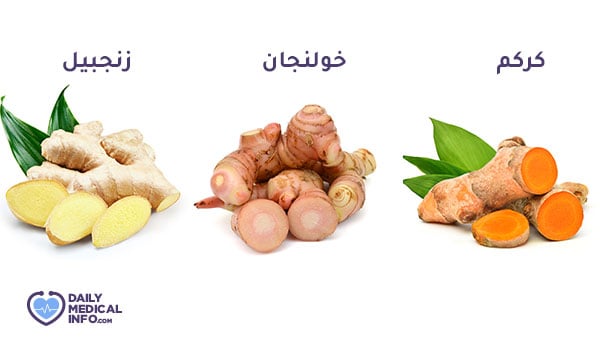What is galangal? What are its benefits and harms?
Have you ever heard of Galangal? Do you know what health benefits they provide, or what they are used for? Learn with us from the following article about the benefits of this plant for the health of the body, and how it helps men in particular, in addition to different ways to use it and some of its potential harms that must be known before using it.
What is galangal?
Galangal is a kind of spice that is mainly found in South Asia, and there is a close relationship that brings it together with some of the most famous spices, especially ginger and turmeric, so that it is very similar to them in shape, and it has been used for years in alternative medicine.
This plant can be eaten fresh or used in cooking, and is believed to offer many different health benefits, ranging from treating inflammation to fighting cancer and more.
The benefits of galangal
Here are some of the most prominent potential benefits associated with the use of galangal:
1- It is full of antioxidants
Galangal roots are a rich source of antioxidants that are important for treating diseases and protecting cells from any damage. Studies have indicated that these roots contain polyphenols, which are a group of antioxidants associated with improving memory and lowering blood sugar and cholesterol levels.
It is also believed that polyphenols protect against mental decline, heart disease and other health benefits, but these benefits still need more scientific evidence.
2- Prevention of cancer
Some laboratory experiments suggest that the active ingredient in galangal, known as galangin, can help kill some types of cancer cells, preventing them from spreading in the body.
Some studies also suggest that it can help protect against skin and liver cancer. It is worth noting that these experiments were conducted on animals, and to prove the same effects and benefits on humans, more studies and experiments are still needed.
3- Fighting inflammation and pain
Galangal root can reduce diseases that cause inflammation, as it contains a phytochemical known as HMP, which according to several animal experiments has anti-inflammatory properties.
The results also indicate that the plant family to which the galangal belongs can somehow help reduce pain associated with inflammation, but more studies are still needed.
4- Protection from infection
The essential oils that are extracted from the roots of galangal can help fight a group of harmful microorganisms. Adding this plant to recipes can reduce the incidence of some types of infections that may occur as a result of undercooking some types of foods.
Some experiments also indicate that the roots of this plant can help kill some harmful bacteria, including E. coli, staph, and salmonella, but again, this benefit still needs more proof.
The benefits of galangal for the colon
As mentioned earlier, galangin is the main and active component of this plant, and some studies indicated that this component has anti-cancer properties. According to some experiments, the anti-colon cancer properties of galangin were particularly studied, and it was found that this element helps in the death and reduction of the DNA concentration of colon cancer cells, according to the dose that is adopted.
Galangin also helped accelerate the death of colon cancer cells by modifying and altering the dysfunction of some of the responsible cell membranes. The final results indicate the potential use of this plant and its components in future treatments to eradicate colon cancer.
Benefits of galangal for men
Some recent studies indicate that galangal can help enhance fertility in men. According to some studies that lasted for several months, it was noted that taking supplements containing galangal and pomegranate fruit extract on a daily basis helped increase sperm motility by 62%. Despite the positive results, the effect of this plant on men’s health still needs more experiments and studies.
Benefits of galangal for women
As we mentioned earlier, this plant contains plant antioxidants known as bioflavonoids that help fight factors that lead to some types of cancer, the most prominent of which for women is breast cancer, and it can also help increase any excess amounts of estrogen in the body, which may also increase the chances of developing breast cancer.
How to use galangal
Since this plant is similar to ginger, it can usually be used and prepared in the same way. It can be boiled, steamed, or used as is. Best ways to use it include:
- Thanks to its good cooking, to obtain a distinctive flavor that matches any other ingredients, it may sometimes be difficult to eat it intentionally due to its hardness.
- It can be steamed to a proper doneness, to prevent any hard pieces from forming when used as an ingredient in some recipes.
- It can be stored in the refrigerator and used at any time as part of various meals such as soups, juices, and more.
- If the roots are used as is, it is recommended to chop or chop them for easy digestion.
Difference between galangal, ginger and turmeric

Here is a comparison between galangal, ginger and turmeric:
- There is a close relationship between the three types, and all of them can be used fresh or added to food.
- Ginger has a sweet and spicy taste, while galangal has a sharp and hot taste, and sometimes tends to taste like pepper, while turmeric has a pungent and bitter taste.
- Studies show that all three provide similar health benefits, as they all offer antioxidant and anti-inflammatory properties.
- All three contain elements that can help prevent some types of cancer.
- Galangal is the only plant among them that offers potential health benefits to promote nomadic health and increase fertility.
- Ginger and turmeric offer potential benefits in reducing the risk of type 2 diabetes and some heart diseases, and given the similarity of the three types to each other, galangal may offer similar benefits, but more studies are still needed.
Galangal damage
It is usually safe to eat this plant, when taken in reasonable amounts, in the same quantities that are normally found in foods. According to some studies, some damages and side effects can appear when consuming galangal in excessive amounts, including the following:
- A drop in energy levels.
- lack of appetite
- Excessive urination.
- diarrhea.
- Possibility of coma.
- Death, in some cases.
Therefore, we recommend that you consult a doctor first before eating this plant, and to find out whether it is safe for health or not, and what are the appropriate quantities of it.

